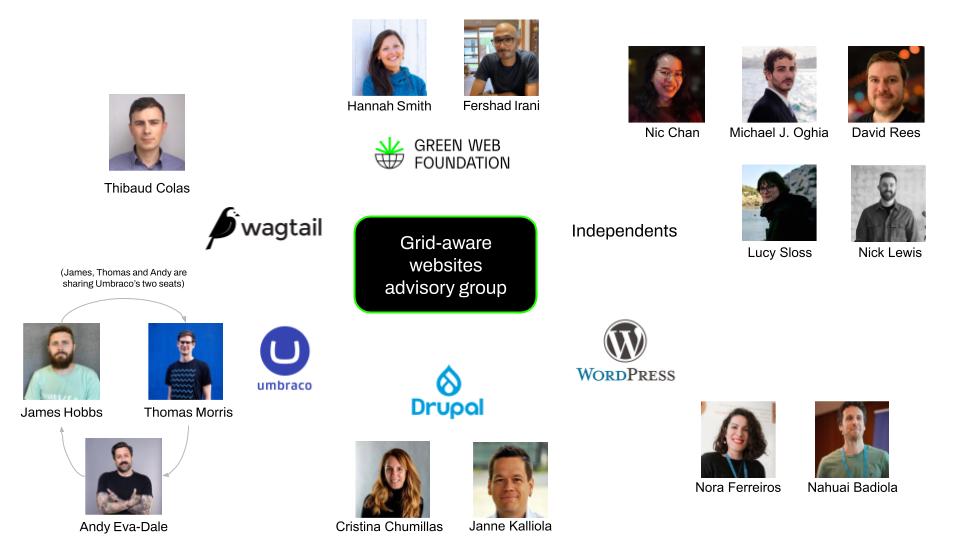I’m lucky to be representing Wagtail as part of the Green Web Foundation’s Grid-aware Websites project. Here are some of my thoughts on the concept, and what I hope to bring back to the Wagtail and Django communities.
Those reflections are from two meetings about the project, the very beginning, so there’s lots to figure out still! But here we are.
For context – read Introducing our grid-aware websites project from the Green Web Foundation, and for even more context, Hannah’s Reflections on our first advisory group meeting for Grid-aware Websites. For the TL;DR; context, this project is about making websites more energy-efficient as and when needed. It’s a collab between the Green Web Foundation, and a panel of Content Management Systems representatives:

A visual representation of the grid-aware websites advisory group. Credit: Green Web Foundation
In practice - if you want a quick real-world example, see the Branch Magazine website.
My TL;DR; take on the grid awareness concept
Lots of site users and stakeholders want lower-footprint websites. Grid awareness makes that possible, since there is so much data available now, live, on how carbon-intense the electricity grid is. The Green Web Foundation’s approach also has the potential to be simple to retrofit onto existing sites and web apps, Wagtail or no. Rolling this out on a site will also increase users’ and stakeholders’ awareness of sustainability, which is a win for all of us.
Project framing
We were asked to reflect on whether, or how, we could make the case that:
A grid-aware website means a better experience for the user.
I’ve struggled a lot with this, as I generally start from the position that we should focus on making a singular default experience better for everyone. However – some people do want lower-footprint websites! It’s a fallacy to assume we can make the one canonical version of a website the best for everyone, as is clear from working on accessibility. Websites, and the web platform generally, are excellently suited to adapt to user needs (color themes, font sizes, responsive, etc).
So 👉️ I believe a grid-aware website can be a better experience if we put users in control of their experience, and their browsing’s footprint. In that scenario, with perhaps different themes or versions of a site available for users to choose from: grid awareness means a better default experience for all, while adapting based on the gri. A good, low-footprint site when needed according to the grid – and users can switch back to a higher-footprint version when they want.
For the project group, in as few words as possible, I put it as:
Website users care about their footprint. They fiddle with website or app controls to lower it. Those added user controls increase user agency, but also cognitive effort. Grid awareness means a safe default. Grid awareness helps users lower their footprint, by automatically adjusting the site when it matters.
Additionally, I believe there are obvious benefits for battery life and data costs of mobile devices. See for example the Save-Data header, and how it’s used by Opera and Android devices. Win win win 🎉!
Grid awareness mental model
It’s been hard for me to have a good mental model of the “grid-aware” mindset, and deciding based on what criteria to switch between the “regular” and “low-footprint” versions of a page. I’m wondering about things like:
- How to communicate this with stakeholders and users who might or might not be aware of the electricity grid, its energy mix, or carbon intensity.
- Whether / how much to try to align this with any website goals (say a target on carbon intensity per page view, or overall Net Zero goals)
- How much to grapple with any social equity considerations. There are a lot of configuration options where the “grid aware” mode would kick in 100% of the time for people in countries with carbon-intensive energy grids. I’m not sure if that’s a good thing or not.
I’ve arrived at those questions when reviewing the options to switch between the “vanilla” and “low footprint” versions of the site. I believe there’ll be lots of people asking themselves which of those to choose from based on their needs.
Terminology for the methodology
One other thing I’ve struggled with a bit is terminology. Is “grid-aware” referring to the website across all versions, or just the one that has a lower energy use? And for site users, how we would communicate what version of the site they’re looking at? (Branch Magazine uses the term “Grid intensity view” which can be “Live”, “Low”, “Moderate”, “High”).
Design philosophy
The last conceptual element I grappled with was when comparing the two modes on the site, which one to consider as the “default”, if any. For example in Responsive Web Design, there was a switch towards a Mobile First design and coding approach. In front-end dev, there’s the progressive enhancement and the graceful degradation philosophies.
A UI-UX catalogue to demonstrate grid awareness
This would be excellent! With assorted case studies, possibly measurements with the excellent Firefox Profiler’s support for power usage metrics.
I’d also like to see very solid examples of grid-awareness on/off controls for site users. Where to place them on the page? Header? Space is at a premium. Footer? Will never be found.
Sharing the project
For Wagtail, I’m hoping we will be able to kick off adoption with a Google Summer of Code project. Beyond that, a solid “zero to grid-aware” tutorial in say 30min (conference workshop friendly format) will also be excellent.
Up next
I’m glad to be part of this! And impressed at how well the Green Web Foundation team facilitates a positive collaboration on such a tricky topic as website sustainability, with so many different stakeholders involved. I’m looking forward to the next meeting!
And for Wagtail – look out for a grid-aware version of our Wagtail.org website, or of the Wagtail user guide website.